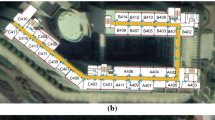Abstract
In case of a crisis event, it is the responsibility of public and government authorities to manage the response operations. Positioning is a crucial task when managing emergency, which aims at estimating the positions of the first responders that act on the crisis site. On the other hand, the radio-based positioning solutions require a process of site survey, in which radio signatures have to be collected and stored in a radio map for further comparison and matching. Site survey involves intensive manual effort and time, which is no feasible during the crisis event. This paper proposes an approach for rapid site survey of the considered area. A specific tool has been developed to draw the site topography and to define the radio map generated by the wireless sensors located in the considered area, by using an accurate signal attenuation model. Experiment results show that the proposed solution can achieve a position accuracy that can be considered acceptable in the context of the rescuers localization even without a site survey activity.













Similar content being viewed by others
Explore related subjects
Discover the latest articles, news and stories from top researchers in related subjects.References
Andrade CB, Hoefel RPF (2010) IEEE 802.11 wlans: a comparison on indoor coverage models. Proc Electr Comput Eng 1:1–6
Aversa R, Di Martino B, Ficco M, Venticinque S (2011) A simulation model for localization of pervasive objects using heterogeneous wireless networks. Simul Model Pract Theory 19(8):1758–1772
Chai X, Yang Q (2007) Reducing the calibration effort for probabilistic indoor location estimation. IEEE Trans Mobile Comput 6(6):649–662
Ekahau ESS (2013) Site survey. http://www.kahau.com/products/ekahau-site-survey/overview.html. Accessed Dec 2012
Ekahau RTLS (2013) Real time location system. http://www.ekahau.com/products/real-time-location-system/overview.html. Accessed Dec 2012
El-Kafrawy K, Youssef M, El-Keyi A, Naguib A (2010) Propagation modeling for accurate indoor wlan rss-based localization. In: IEEE 72nd Vehicular Technology Conference, vol 1. Ottawa, ON, pp 1–5
Esposito C, Cotroneo D, Ficco M (2009) Calibrating rss-based indoor positioning systems. In: IEEE International Conference on Wireless and Mobile Computing, Networking and Communications (WIMOB 2009), vol 1. Marrakech, pp 1–6
Ficco M, Palmieri F, Castiglione A (2013) Hybrid indoor and outdoor location services for new generation mobile terminals. Pers Ubiquitous Comput
Ficco M, Russo S (2009) A hybrid positioning system for technology-independent location-aware computing. Softw Pract Exp 39(13):1095–1125
Hashemi H (1993) The indoor radio propagation channel. Proc IEEE 81(7):943–968
Hata M (1980) Empirical formula for propagation loss in land mobile radio services. IEEE Trans Veh Technol 29:317–325
Hightower J, Borriello G (2001) Location systems for ubiquitous computing. IEEE Comput Mag 34(8):57–66
ISO (2013) International organization for standardization, guide to the expression of uncertainty in measurement (gum)-supplement 1: Numerical methods for the propagation of distributions. International Organization for Standardization, ISO draft guide DGUIDE99998. http://www.bibsonomy.org/bibtex/2eea813f6ec9a5d910a-87439a5b453a19/eutrimer
Kaemarungsi K, Krishnamurthy P (2004) Modeling of indoor positioning systems based on location fingerprinting. In: Twenty-third Annual Joint Conference of the IEEE Computer and Communications Societies (INFOCOM 2004), vol 2. pp 1012–1022
Krumm J, Platt JC (2003) Minimizing calibration efforts for an indoor 802.11 device location measurement system. Technical Report, Microsoft Research
Ladd A, Bekris K, Marceau G, Rudys A, Kavraki L, Wallach D (2002) Robotics-based location sensing using wireless ethernet. Proceedings of the 8th annual International Conference on mobile computing and networking (MobiCom), pp 227–238
Liang G, Bertoni HL (1998) A new approach to 3-d ray tracing for propagation prediction in cities. IEEE Trans Antennas Propag 46:853–863
Lim C, Volakis JL, Sertel K, Kindt RW, Anastasopoulos A (2006) Deployment of rss-based indoor positioning systems. Int J Wirel Inf Netw 54(6):1781–1725
Liu H, Darabi H, Banerjee P, Liu J (2007) Survey of wireless indoor positioning techniques and systems. IEEE Trans Syst Man Cybern Part C: Appl Rev 37(6):1067–1080
Lott M, Forkel I (2001) A multi-wall-and-floor model for indoor radio propagation. Proc Veh Technol 1:464–468
Neskovic A, Neskovic N, Paunovic G (2000) Modern approaches in modeling of mobile radio systems propagation environment. IEEE Commun Surv Tutor 3(3):2–12 (quarter)
Ophir L, Bitran Y, Sherman I (2004) Wi-fi (ieee 802.11) and bluetooth coexistence: issues and solutions. In:Proceedings of the 15th IEEE International Symposium on personal, indoor and mobile radio communications (PIMRC 2004), pp 847–852
Remley KA, Anderson HR, Weisshar A (2000) Improving the accuracy of ray-tracing techniques for indoor propagation modeling. IEEE Trans Veh Technol 49(6):2350–2358
Sarkar TK, Ji Z, Kim K, Medour A, Salazar-Palma M (2003) A survey of various propagation models for mobile communication. IEEE Antennas Propag Mag 45(3):51–82
Seidel SY, Rappaport TS (1994) Site-specific propagation prediction for wireless in-building personal communication system design. IEEE Trans Veh Technol 43(4)
Spencer QH, Jeffs BD, Jensen MA, Swindlehurst AL (2000) Modeling the statistical time and angle of arrival characteristics of an indoor multipath channel. IEEE J Sel Areas Commun 18(3):347–360
Tam JWK, Tran VN (1995) Propagation modeling for indoor wireless communication. Electron Commun Eng J 7:221–228
Wu C, Yang Z, Liu Y, Xi W (2012) Will: wireless indoor localization without site survey. In: Proceedings of the IEEE INFOCOM, pp 25–30
Youssef M, Agrawala A (2004) Handling samples correlation in the horus system 2:1023–1031
Zhao J, Wang Y., Yang Q (2009) Hips: A calibration-less hybrid indoor positioning system using heterogeneous sensors. In: Proceedings of the IEEE International Conference on Pervasive Computing and Communications, pp 1–6
Author information
Authors and Affiliations
Corresponding author
Rights and permissions
About this article
Cite this article
Ficco, M. Calibration-less indoor location systems based on wireless sensors. J Ambient Intell Human Comput 5, 249–261 (2014). https://doi.org/10.1007/s12652-013-0192-9
Received:
Accepted:
Published:
Issue Date:
DOI: https://doi.org/10.1007/s12652-013-0192-9




